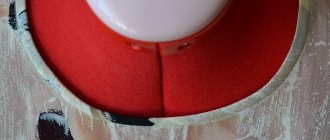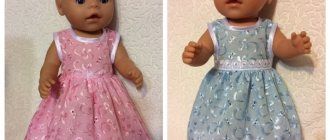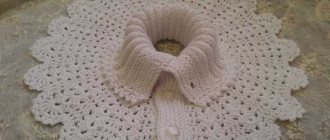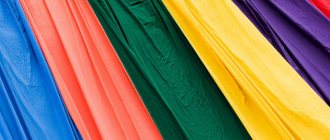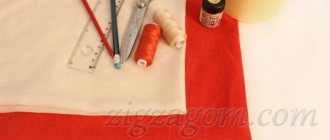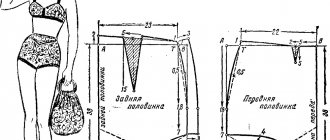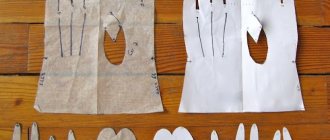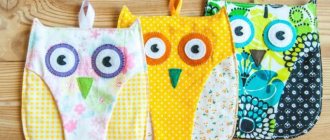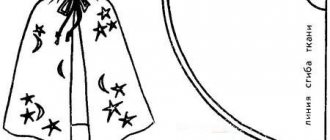Today you can find anything in stores, the range of products is so wide that consumers’ eyes run wild from this abundance. But the main problem is that as soon as a new fashion trend appears, the market is filled with similar things. As a result, 85% of fashionistas wear stylish things and only 15%, for various reasons, prefer to create their own style rather than chase changing fashion.
Pink polyester bag
If you want to stand out from the crowd and amaze others with an unusual accessory or item, all you need is basic sewing skills, a great desire and the necessary tools. A DIY fabric bag can become a real masterpiece and an exclusive item.
We sew ourselves
It is difficult to imagine a woman's wardrobe without several handbags of different colors, different in style and type of material. This accessory has long become an integral part of a woman’s look; even the smallest babies take a handbag with them when going for a walk.
You can sew a bag of any style and size yourself, it all depends on your preferences. Moreover, it is not at all necessary to have a seamstress diploma to create a beautiful product from fabric. It is enough to know how to use a sewing machine and insert a thread into a needle, plus to these skills you need to add diligence and the desire to create a unique thing.
[do_widget_area sidebar5]
Shoulder bag
Doubt your imagination? It's okay, in the virtual space you can find a lot of design options and a variety of handbag patterns. All that remains is to decide what fabric you will sew the bag from.
Types of textile bags and their use
There are many models of textile bags. And the fashion for them is not always dictated by famous manufacturers. Textiles give any needlewoman the opportunity to create her own masterpieces, at the sight of which all fashionistas turn green with envy. To summarize, all models can be divided into the following types:
- Bags are a very popular type of textile bag this season. Sew with one or two handles. They are made long to carry such a bag over the shoulder. Such models are adored by young people, students and women leading an active lifestyle. These products are valued for their spaciousness and variety of designs;
- Shopping bags. They are also called textile bags. Such models are indispensable when going to a store, market or supermarket. Made from durable fabrics, they can withstand heavy weight. Very often, it is these simplified models that are used to apply advertising images. They are usually sewn from spunbond - a very versatile and widely used material. These bags come in different sizes and colors, but they all have a simple shape and cut;
- Classic bags with one or two handles. These models are made either with textile handles, or use other materials, including wood or metal. When creating such models, designers are limited only by their imagination, since absolutely any fabrics and decorative elements are suitable for these products;
- Clutches. Small bags for special occasions or parties. The shape of such models can be any, from a small bag to a product on a solid base. Non-traditional materials are used for them: velvet, silk, satin, which is not surprising, because they are more decorative than practical;
- Briefcases. These are mainly children's models for school, but they are often used by adults to carry and store papers, documents, and equipment, such as laptops and tablets.
Any of these bags can be bought both in a real and online store. If you wish, you can sew such products yourself, but today manufacturers offer such a selection of ready-made bags that this is not necessary.
Which fabric to choose
The fabric market is filled with various products; without proper experience, it is difficult to understand this variety and make the right choice. To make this process easier for you, let’s figure out which type of fabric is suitable for which handbag:
- Polyester, the material can be used to make a durable bag;
Polyester
- Nylon accessories are lightweight and highly durable. Nylon has good elasticity, so it is often used in factories for sewing handbags;
Nylon
- One of the most popular materials in the field of bag making is leatherette. However, most of its characteristics are far from ideal. Most often used for the manufacture of consumer goods. Such accessories have a low cost, but their service life is minimal;
Faux leather
- Faux suede, a very practical material that is resistant to wear. It makes elegant and stylish products;
Faux suede
- Jacquard, expensive fabric. Usually used for sewing children's backpacks;
Jacquard
- Cotton contains 90% cellulose. Suitable for making any type of handbags.
Cotton
If you decide to sew a bag from fabric, you don’t have to go to the store and look for material. Surely you have a piece of good fabric at home that can be used to create your own masterpiece in the Hand Made style.
Which handbag to choose
Before starting work, you need to decide on the purpose of the handbag: everyday, household, children's, beach, evening. With an understanding of the functionality of the accessory, it will become easier to select the material. Then select the form:
- in the form of a bag - usually it consists of two sides, without a bottom;
- bag – used for household needs;
- waist – attached to the waist, suitable for walking;
- rectangular - this model has side walls and a bottom;
- backpack - for children the little thing is decorated with bright appliqués;
- original - in the form of animals, flowers.
Sew a shoulder bag
This model is considered the most comfortable, put it on your shoulder and forget it. It looks stylish, is practical and comfortable - ideal characteristics for a handbag. Sewing it will require a lot of time, but the result will compensate for the hours spent.
DIY bags - pattern
You'll need:
- Lining material;
- Fabric for the product (denim, suede, etc.). Size of the pieces: 34*35 and 34*27, you will also need a couple of small pieces of 27*13 centimeters;
- Forty centimeters of lace;
- Doublerin;
- Two carabiners and a pair of half rings;
- Magnetic button;
- Strap;
- Scissors, ruler and other necessary tools.
If you have everything you need, you can start sewing:
- To begin with, the front side of the fabric is glued with doublerin so that the bag retains its shape well in the future;
- We fold two large pieces with their right sides facing each other and sew them together. Don't forget about the seam allowance, leave about 1.5 centimeters;
- Iron the seams, attach the lace to the front side and stitch it;
- Sew the side seams;
- We form the bottom. Fold the corners and secure everything with pins. We measure approximately seven centimeters from the sharp edges, draw a line with a pencil, and sew;
- Turn the fabric inside out and iron the side seams. The workpiece is ready;
- We sew a valve, a mandatory element of this model. Take two small pieces and fold them right sides together. Draw the shape of the pocket, round the corners;
- We sew the drawn outline;
- We cut off the excess fabric. We mark the middle on the valve, put a dot there, this is where the button will be attached;
- From the point, measure 1.5 centimeters in two directions, make cuts in the fabric and insert the fittings, turn the fabric inside out;
- We connect the bag and the valve;
- We bend the flap onto the front side of the product and mark the place where you need to attach the magnet;
- We attach strips of leather with sewn half rings for a belt to the side seams;
- For the lining you will also need a pattern and a piece of fabric measuring 30*34 centimeters;
- We sew them along the perimeter, leaving the seam open, cut off the corners, turn the material inside out, stitch the open seam;
- Attach the lining to the bag and stitch it.
Your accessory is ready, all you have to do is turn it out and you can “walk” the new item.
Recommendations
If you have no experience in sewing a leather bag yourself, it is better not to take on new leather. It is better to use old leather as a training ground. For these purposes, you can disassemble an old, unnecessary leather raincoat. He will give you the necessary skills to work with genuine leather, teach you how to correctly plan patterns and make calculations.
As a material and experimental base, it is recommended to use the Internet, various programs “we sew bags with our own hands”, use master classes, patterns of other people
Note!
DIY satin ribbon bows: photos of original design ideas, step-by-step DIY master classDIY hair bands - ideas for decorating homemade rubber bands + step-by-step instructions for making them yourself
DIY shadow theater: step by step how to do it at home! 175 real photos
Bag patterns
How to create the accessory of your dreams without knowing how to sew? Patterns will come to the rescue, in which everything is described in detail; even inexperienced craftswomen will be able to figure them out.
Bag pattern
Popular patterns for DIY fabric bags:
- A denim handbag never goes out of style. If you have jeans in your wardrobe that you don’t mind parting with, then you can use them to create a stylish denim accessory. The photo shows a detailed pattern and the final result of the work;
- Men's fabric bags can also be unique and will perfectly complement your man's look. It’s not difficult to sew a beautiful product if you have a detailed pattern with dimensions printed on it;
- Fabric shopping bags are the easiest to sew. Having the necessary pattern is 50% of successful work. You can use any material at your discretion.
If you decide to try your hand at sewing for the first time, don’t panic and give up on your idea, watch a detailed video on how to sew a bag with your own hands. There is no need to be afraid of experiments, and then you will surely create a real masterpiece that will be the envy of famous designers.
What can you make a bag from?
To make an accessory, any materials are used, not necessarily new ones: it can be old worn jeans, sweaters, leather jackets. Buttons, belt buckles, and laces are used to decorate a handbag. If you are proficient in knitting techniques, then making a pattern and crocheting or knitting a new item will not be difficult for you.
Textile
The material must be wear-resistant, hold its intended shape and fully correspond to the chosen style of the handbag.
- Fabric - use denim, cotton, synthetic or denser (for example, jacquard).
- Fur – natural or artificial. To protect it, the inside of the bag is lined. This is technically difficult to accomplish, and if you are new to sewing, it is better to use fur as a finishing element.
- Leather and suede are difficult materials to work with: if your machine cannot cope with the strength of the material, you will have to do the stitches by hand. But the result will be impressive. Sewing women's leather bags is a labor-intensive but fascinating process.
- Felt is valued by craftswomen for its ease of use: the edges of the material do not fray and do not require additional processing. Embroidery looks beautiful on felt as a decoration.
- Burlap is a rough material, but in skillful hands it turns into a beautiful and durable product in a rustic style.
- Old clothes are a time-tested material for creativity: T-shirts, jeans, T-shirts - everything can be altered, decorated and given a second life to your favorite things.
Yarn
There are two ways to knit a handbag:
- Using knitting needles, choose any thread: to create voluminous patterns, choose thick yarn. The modern market offers a huge selection of knitting threads of different colors and thicknesses. Note that the choice of bag shapes when knitting will be small. The product will have to be reinforced with a lining and side seams made;
- Crochet - with the help of this simple device they create original shapes and patterns for the accessory. A distinctive feature is that the fabric is knitted entirely, without creating seams. To decorate a knitted handbag, tassels, pompoms, ribbons, and wooden buttons are used.
How to choose the right material
You can create a bag from any material you like. Before you start sewing, you should decide for what purposes this item will be used.
If you are making an everyday version, then you should choose a fabric that is more durable and resistant to external irritants.
Product example
List of common materials for making bags:
- Jeans. This material is often used by fashionistas to create a fashionable handbag. Density, ease of care and increased wear resistance are the main criteria when choosing. A small handbag can be made from old jeans.
- Cotton. Natural and dense fabric is perfect for sewing. Cotton lends itself well to styling. A wide variety of colors will allow you to make a handbag to suit every taste.
- Polyester. Cheap cotton substitute. It has the ability to repel stains and has a variety of colors available in the market. It is worth taking a closer look at such fabric before sewing the product.
- Gabardine. Another representative of artificial fabric. It perfectly repels moisture and dirt, does not wrinkle, and the finished product can be machine washed.
- Jacquard. DIY bags made from furniture fabric do not require additional decoration and are quite durable to wear. Furniture fabric is often used by fashionistas to sew accessories.
Interesting to know! When sewing a product, you should give preference to coarser and more durable types of fabric. It is this that will allow the bag to maintain its favorable appearance for a long time.
Criteria for choosing the right backpack for a first grader
Weight
SANPIN 2.4.7/1.1.1286-03 states:
2.8. Hygienic requirements for briefcases, school bags and similar products for children 2.8.1. The weight of briefcases, school bags and similar products (hereinafter referred to as products) for primary school students should be no more than 600 - 700 grams , for middle and high school students - no more than 1000 grams.
I'll tell you right away. Finding a lightweight, correct backpack that fits within the stated SanPiN limits is very difficult. Here, let's assume that all children are different. At the time of the first trip to school, one child’s build is quite similar to that of a third grader, but the other cannot be more than 5 years old.
If your child is small in height and general build, there are no options - look for the lightest backpack, weighing no more than 700 grams.
For example, the ErichKrause brand has a series of “ErgoLine” backpacks, the weight of which does not exceed 700 grams. ErichKrause satchels of the “ErgoLine” series at very competitive prices can be viewed here
If finances allow, you can consider backpacks from the German brand DerDieDas of the “Ergoflex Superlight” series, which are also light in weight. All backpacks from this company come with filling (a sports bag, a folder for educational material, a pencil case with filling, and a pencil case without filling are included with the backpack). The range of backpacks filled with the DerDieDas brand of the Ergoflex Superlight series is presented here
But, nevertheless, it is worth recognizing that the choice of backpacks weighing up to 700 grams. very limited. For this reason, if the build of a future first-grader is average (normal) or large, I believe it is possible to deviate slightly from the stated SanPiN 700 gr. to the greater side.
The main thing is to remember that, according to standards, a backpack FILLED with school supplies should not weigh more than 10% of the child’s weight
That is, if you choose a fairly heavy backpack, you will need to carefully monitor the total weight of the backpack and all the things in it.
A proper backpack cannot be completely light, because... its frame and back are made of rigid materials. If you find a suspiciously light backpack, check such characteristics as the presence of a frame and a rigid back. Perhaps they simply don’t exist and they offer you an ordinary backpack. And we remember that wearing a soft backpack without a hard back can have bad consequences for the child’s spine.
Size
According to the already familiar SANPIN 2.4.7/1.1.1286-03:
2.8. Hygienic requirements for briefcases, school bags and similar products for children…………… 2.8.3. The dimensions of products for primary school students must meet the requirements of these sanitary rules (Table 5):
Requirements for product sizes for primary school students:
| Indicators | Safe level mm (increase in dimensions by no more than 30 mm is allowed.) |
| Height | 300 — 360 |
| Width | 220 — 260 |
| Depth | 60 — 100 |
| Shoulder strap length, not less | 600 — 700 |
| The width of the shoulder belt in the upper part (over 400 - 450 mm), not less | 35 — 40 |
I slightly adjusted the names of the indicators in the table to make it more clear)
Of course, I checked the compliance of the recommended SanPiN sizes with the parameters of our backpack. The dimensions of our backpack turned out to be: Height - 33 cm (330 mm) Width - 25 cm (250 mm) Depth - 13 cm (130 mm)
It seems that everything fits into the norms) The depth of the backpack, however, turned out to be with the maximum recommended figure (130 mm), but it is what it is. I assessed the length of the shoulder strap (straps) visually - it is clearly not less than the stated standards. The length of the belt should allow the backpack to be adjusted according to the child’s height. We’ll talk about the width of the belt (straps) a little lower.
In general, based on the dimensions recommended by SanPiN, a backpack for a first-grader in terms of general parameters (height, width, depth) should be as compact as possible. But, taking into account the fact that the size of an A4 book (21x30 cm) should fit freely into it . Because many educational materials in elementary school will be of this size.
Here is a test of our backpack: a sheet of A4 format can be easily stored in it:
And, again, we look at our child.
When determining the correct size of the backpack, we make sure that: - the top of the backpack does not rise above the child’s shoulders - the bottom is not lower than the lower back - the width of the back of the backpack is no wider than the shoulders
Some mothers, in order to save money, prefer to buy a backpack for their child immediately for growth. So that it is enough for the entire elementary school and, preferably, also for a couple of middle classes. This is not recommended. Firstly, the standards were developed for a reason and a backpack that is too large can be very harmful to the child. Secondly, let's admit that large backpacks on the back of a small child look very ugly and even funny.
Cordura
This fabric was developed in the USA specifically for the needs of the army. The goal was to come up with a material that would have improved strength characteristics and could be used for sewing army ammunition.
The resulting material, which is made from nylon, exceeded all expectations and began to be actively used not only for military purposes. Thanks to the special twisting of the fiber, Cordura is several times stronger than raw nylon.
Cordura fabric is most often used by manufacturers to create professional outdoor gear, including backpacks. You can also find models of men's urban backpacks made of Cordura.
This fabric is really very durable, reliable, and also moisture resistant. Cordura backpacks and bags can be machine washed, but keep in mind that this material takes a long time to dry.
Important! Cordura is not suitable for use in extreme cold temperatures. In severe frost, the canvas begins to lose its properties and may crumble.
Also, the disadvantages of the fabric include its high cost. But if you are looking for “indestructible” material for a backpack, then this is what you need.
Pattern for a backpack
If you are taking on sewing for the first time, it is better to use a pattern. It will help you sew the desired product correctly.
To create backpack patterns with your own hands, purchase special graph paper. Place all the parts of the backpack on it, leaving space for the seams.
DIY tennis skirt: create a pleated skirt with your own handsThe latest running accessories
- How to dry clothes at home?
Place the cut out parts on the fabric and trace the outlines. Secure with bobby pins so that the paper does not move and cut out. And then it’s all a matter of needle and thread.
Beach bag
A fabric bag is considered a good option for towels, mats, stoles and other beach essentials. And here is an easy way to sew a beach bag yourself.
To do this, you can prepare one type of dense fabric. Or combine several pieces of material. You need to cut out two identical rectangles from it, as well as parts for two sides and a bottom.
Large elements of the bag are stitched on the side where the handles will be attached, with marks applied. Then the bottom and sides are sewn to them. You can sew ribbon of a matching color as handles.
